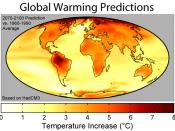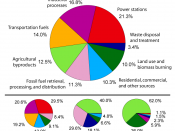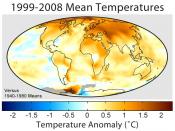Global WarmingGlobal warming is the increase in the average temperature of the Earth's near-surface air and oceans since the mid-20th century and its projected continuation.. Global surface temperature increased 0.74 ñ 0.18 ðC (1.33 ñ 0.32 ðF) during the 100 years ending in 2005.Climate model projections indicate that global surface temperature will likely rise a further 1.1 to 6.4 ðC (2.0 to 11.5 ðF) during the twenty-first century. Increasing global temperature will cause sea levels to rise and will change the amount and pattern of precipitation .Global temperatures have increased by 0.75 ðC (1.35 ðF) relative to the period 1860ÃÂ1900.Since 1979, land temperatures have increased about twice as fast as ocean temperatures (0.25 ðC per decade against 0.13 ðC per decade). Temperatures in the lower troposphere have increased between 0.12 and 0.22 ðC (0.22 and 0.4 ðF) per decade since 1979.
Technology and Global WarmingExisting technologies could stop the escalation of global warming for 50 years and work on implementing them can begin immediately.
The scientists identified 15 technologies -- from wind, solar and nuclear energy to conservation techniques -- that are ripe for large-scale use and showed that each could solve a significant portion of the problem. Their analysis, published in the Aug. 13 issue of Science, indicates that many combinations of these 15 technologies could prevent global emissions of greenhouse gasses from rising for the next five decades.
How can we help?1.) Eliminate all subsidies to fuel use.
Subsidies to energy R&D cost taxpayers millions of dollars while producing minimal benefits. An international agreement aimed at ending energy subsidy with binding targets would be a significant victory for emissions reduction.
2.) Reform Air Traffic Control Systems.
Greater demand for air travel means more flights, which means greater fuel use and increased emissions. Yet, the current...


